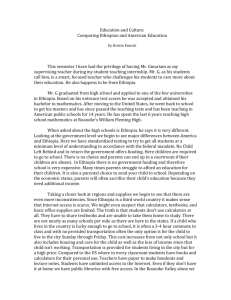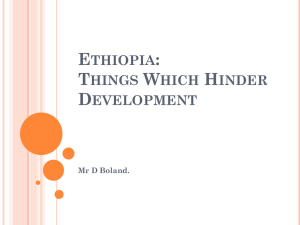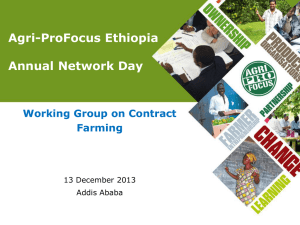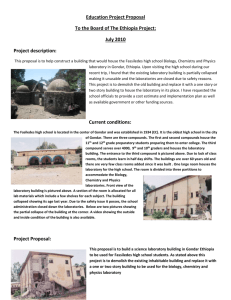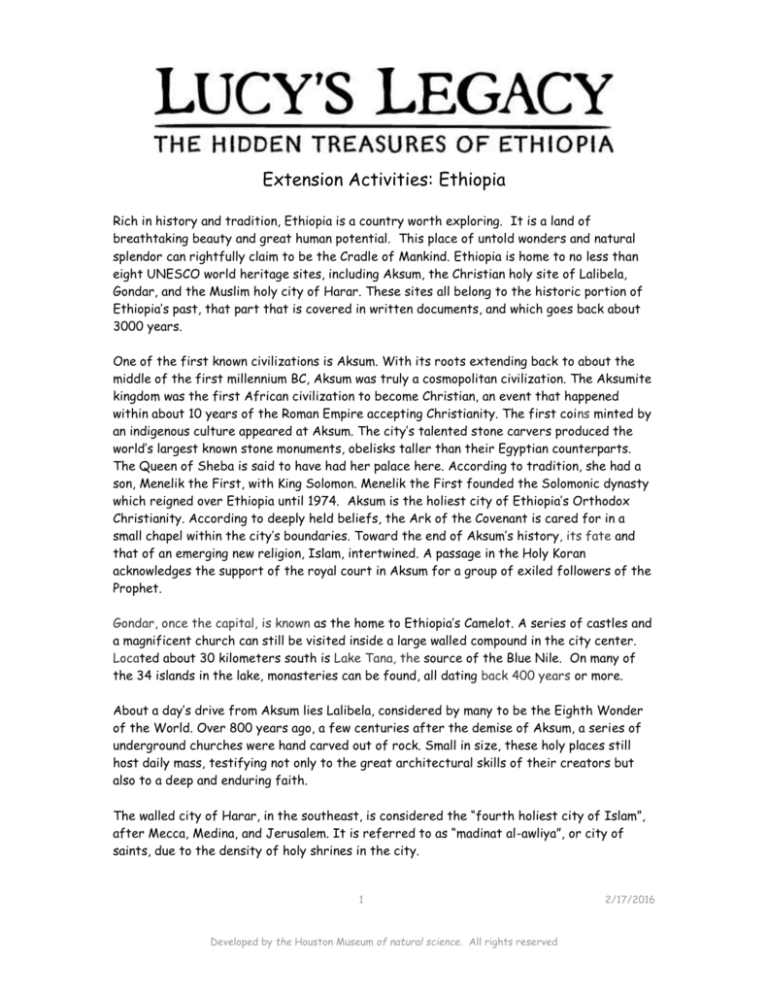
Extension Activities: Ethiopia
Rich in history and tradition, Ethiopia is a country worth exploring. It is a land of
breathtaking beauty and great human potential. This place of untold wonders and natural
splendor can rightfully claim to be the Cradle of Mankind. Ethiopia is home to no less than
eight UNESCO world heritage sites, including Aksum, the Christian holy site of Lalibela,
Gondar, and the Muslim holy city of Harar. These sites all belong to the historic portion of
Ethiopia’s past, that part that is covered in written documents, and which goes back about
3000 years.
One of the first known civilizations is Aksum. With its roots extending back to about the
middle of the first millennium BC, Aksum was truly a cosmopolitan civilization. The Aksumite
kingdom was the first African civilization to become Christian, an event that happened
within about 10 years of the Roman Empire accepting Christianity. The first coins minted by
an indigenous culture appeared at Aksum. The city’s talented stone carvers produced the
world’s largest known stone monuments, obelisks taller than their Egyptian counterparts.
The Queen of Sheba is said to have had her palace here. According to tradition, she had a
son, Menelik the First, with King Solomon. Menelik the First founded the Solomonic dynasty
which reigned over Ethiopia until 1974. Aksum is the holiest city of Ethiopia’s Orthodox
Christianity. According to deeply held beliefs, the Ark of the Covenant is cared for in a
small chapel within the city’s boundaries. Toward the end of Aksum’s history, its fate and
that of an emerging new religion, Islam, intertwined. A passage in the Holy Koran
acknowledges the support of the royal court in Aksum for a group of exiled followers of the
Prophet.
Gondar, once the capital, is known as the home to Ethiopia’s Camelot. A series of castles and
a magnificent church can still be visited inside a large walled compound in the city center.
Located about 30 kilometers south is Lake Tana, the source of the Blue Nile. On many of
the 34 islands in the lake, monasteries can be found, all dating back 400 years or more.
About a day’s drive from Aksum lies Lalibela, considered by many to be the Eighth Wonder
of the World. Over 800 years ago, a few centuries after the demise of Aksum, a series of
underground churches were hand carved out of rock. Small in size, these holy places still
host daily mass, testifying not only to the great architectural skills of their creators but
also to a deep and enduring faith.
The walled city of Harar, in the southeast, is considered the “fourth holiest city of Islam”,
after Mecca, Medina, and Jerusalem. It is referred to as “madinat al-awliya”, or city of
saints, due to the density of holy shrines in the city.
1
Developed by the Houston Museum of natural science. All rights reserved
2/17/2016
Over time, Ethiopia’s involvement with the outside world became more intense. During the
Middle Ages, Europeans came to Ethiopia primarily looking for the legendary Prester John, a
Christian patriarch and king said to rule over a Christian nation lost amidst the Muslims and
pagans in the Orient. Later European countries became more aggressive. Ethiopia maintained
its independence, defeating an invading Italian force at the battle of Adwa in 1896, a
victory which is still celebrated today. This country is unique in that it has never been
colonized.
A long line of emperors which began in Aksum some 2000 years ago came to an end with His
Imperial Majesty, Emperor Haile Selassie. The end of his reign in 1974 marked the end of
one of the world’s longest reigning dynasties.
Atlas Activity
On a map show that Ethiopia is located in the northeastern part of the African continent, an
area that is known as the “Horn of Africa”. Explain that Ethiopia is a country in Africa like
the United States is a country in North America.
Have students list other countries in North America. This will reinforce the fact that
continents may be comprised of many countries. Ask the students to list other countries
that are located in Africa and point these out on the map as they are being listed.
Provide students with an outline drawing of Africa. Students can work in pairs using an
atlas and any other reference sources to draw and label the countries located in Africa.
Mapping Ethiopia
Have students draw the shape of Ethiopia on a piece of paper. Reference the Web site
below to give the students fun facts while they are drawing. For example, did you know that
the country of Ethiopia is twice the size of Texas?
http://ethiopianexcursion.com/interestingfacts.htm
Once the students have completed the outline of Ethiopia have them label the cities of
Addis Ababa, Axum, Gondar, Lalibela, and Hadar. Mark Hadar with the letter “L” to signify
where Lucy was found. Lightly shade the area known as the Great Rift Valley.
Discovering Ethiopia
Discuss the geographic factors that influence the lifestyles of the people in a particular
area. Divide the class into at least five groups to research on the geography of Ethiopia
influences the housing, transportation, dress, food, livelihood, etc. of its people. Have each
group give a visual and oral presentation of their findings.
Addis Ababa
Addis Ababa, founded in 1886, is the capital of Ethiopia and is located in the center of the
country. Addis Ababa is a bustling city with a population over three million people. Addis
Ababa is home to several museums including the Ethiopian National Museum that houses the
2
Developed by the Houston Museum of natural science. All rights reserved
2/17/2016
fossilized skeleton and a plaster replica of the early hominid Lucy. The elevation of Addis
Ababa is about 8,000 feet, 1.5 miles high, making it the third highest capital in the world.
To help the students with a reference point, mention that Denver, Colorado is 5,280 feet or
1 mile high and is nicknamed the “Mile High City”. Which two countries have capital cities
located above 8,000 feet?
Capital Cities Activity
Students will compare capital cities of the world. Give examples like Washington D.C.,
Beijing, Bogotá, Cairo, etc. Ask the students if they have ever visited Washington D.C.
Discuss what did they might see, do, or learn while visiting our nation’s capital. Brainstorm
other capitals and any important facts they might know about a capital.
Divide students into pairs. Each pair should gather information from the internet or library
about Addis Ababa and one other capital. (To save time a teacher could gather this
information and create handouts.) Create a Venn diagram comparing and contrasting their
assigned capital to Addis Ababa. Share each Venn diagram with the class.
Addis
Ababa
________
____
Aksum
Aksum is located in northern Ethiopia near the border of the country of Eritrea. Aksum was
created by the Queen of Sheba around 500 BC, and it was a powerful city in the Ethiopian
Kingdom during this time. The people of Aksum, known as Aksumites, were famous for their
architecture and crafts. Tourists today visit the city to see the ancient obelisks and
stellae.
The word “obelisk” comes from a word meaning “needle” and is a tall, narrow, four-sided
monument that ends in a point. A famous obelisk in Washington, D.C. is the Washington
Monument. A stellae is similar to an obelisk in that it is an upright stone structure with an
inscribed or sculptured surface.
Each obelisk in Aksum is marked with beautiful carvings that represent ancient rulers.
Discuss with your students other monuments in the world that are meant to mark graves of
3
Developed by the Houston Museum of natural science. All rights reserved
2/17/2016
ancient rulers. Examples are the pyramids of Egypt or the mausoleum of the First Qin
Emperor in China that is home to the Terra Cotta Warriors.
Italy’s obelisk?
When Italy’s Prime Minister Benito Mussolini invaded and occupied Ethiopia in 1937, he had
one obelisk removed to Italy. For years the Ethiopian government fought to have the
obelisk returned, and in 2005 the 1,700 year old obelisk was again at home in Aksum.
Older students may conduct research charting the struggle to return the obelisk taken to
Italy in 1937. Include the process of transporting a relic of that size.
Younger students may conduct additional research on obelisks around the world. Compare
and contrast the different styles. How are they alike or different from Ethiopian obelisks?
Making Obelisks/Stellae
After discussing and showing pictures of the obelisks and stella ask each student to draw
their own obelisk/stella. The markings should represent their life to future generations. If
time permits allow the students to create a 3-D model out of clay or wooden sticks and
markers. Students may present their obelisk to the class and explain why they chose to
decorate it the way they did.
**You may also use the drawing below to decorate and cut out.
4
Developed by the Houston Museum of natural science. All rights reserved
2/17/2016
Directions: Decorate your stella then cut out the drawing and the description below. Fold your drawing at
the dark lines to form a 3-D model, tape or glue “flap B” behind “flap a”. Fold each corner of the
description down to create a base for your stella. Use tape or glue to hold your stella and base together.
(Be sure that you are still able to read the description.)
Description
Stella Drawing
Flap A
Flap B
Houston Museum of
Natural Science
Volunteer Guild
23 Aug 07 ii
5
Developed by the Houston Museum of natural science. All rights reserved
2/17/2016
Gondar
Gondar, a city south of Aksum, is located in northwestern Ethiopia at the foot of the Simien
Mountains. Emperor Fasiladas founded the city in 1634 AD and sought to create magnificent
palaces. His determination led to his first castle being built during the late 1630’s. The
emperor’s successors created castles that stand today making Gondar an enormous tourist
attraction and earning it the nickname “The Camelot of Africa”.
Castle Collage
Ask the students to cut pictures of castles from magazines or print them from the
internet. Use one large poster board and have each student glue his picture on it to create
a collage. Try not to cover anyone else’s picture. Once the class collage is complete, ask the
students to gather around and look at all the different pictures. Lead a class discussion
about the similarities and differences in the styles of the castles. Use questions such as:
Which castle do you think will be safest from attack?
Which castle looks the oldest?
Which castle would you want to live in?
What shapes were used to build the different castles?
How do you think these castles were built?
Why do you think the castles were build?
Tell the students to pretend that they are Emperor Fasiladas and are faced with the task
of building the first castle. Using the information gained from the discussion, have the
students decide where they would build their castle and explain why. They should include
how it will be defended and a detailed description of what would be integrated within the
castle walls. Ask the students to make a drawing or 3D model to accompany their
description.
World Architecture
Show the students a variety of examples of world class architecture, including palaces,
temples, homes, government buildings, and castles. Remind the students of Emperor
Fasiladas’ castles in Gondar, Ethiopia and the importance that he placed on their structure.
In small groups or pairs instruct the students to research and create a Power Point about
one of the world’s great architectural structures. Students should conclude their Power
Point by addressing the question, “Should this structure be preserved?” Some suggestions
are:
Angkor Wat (Cambodia)
The Vatican (Rome)
Prague Castle (Prague)
Alhambra (Spain)
The National Palace (Mexico City)
The Great Kremlin Palace of the
Romanov Family (Russia)
Taj Mahal (India)
Versailles (France)
Cheverny (France)
Chateau Chenonceau (France)
Blarney Castle (Ireland)
Buckingham Place (London)
The White House (United States)
Monticello (Virginia)
Mt. Vernon (Virginia)
Lichtenstein Castle
(Württemberg, Germany)
The Forbidden City (China)
Angers (France)
6
Developed by the Houston Museum of natural science. All rights reserved
2/17/2016
Fairytale “The Camelot of Africa”
Ask the students to create a story/fairytale based on facts about Emperor Fasiladas and
his castles in Gondar. Pretend that you are traveling through Ethiopia and come upon one of
his castles. Using the castle as the setting, write a story about your time there. Include
information about what life was like, what types of meals you ate, how the household was
run, who you met, types of entertainment, etc.
Lalibela
Lalibela, one of Ethiopia’s holiest cities, is located in northern Ethiopia, south of Aksum and
Gondar. Lalibela is known for its eleven stone or rock churches. The city was originally
named Roha but was renamed in honor of King Lalibela for his work in authorizing the
building of the town’s magnificent churches during his reign in the late twelfth century and
early thirteenth century. The churches are within walking distance of each other. Some are
still attached to the rock they are carved out of while others are free standing. The most
famous of the churches is Bieta Giyorgis (Saint George) which is carved into the shape of a
cross. All of the stone churches are still used today and are visited by tourists and
worshipers from around the world.
Sand vs. Rock
Ask your students if they have built a sandcastle while they were at the beach or in a
sandbox. Did they begin by getting the sand wet? Did they pack the sand into buckets, or
did they form the shape of their sandcastle by hand? Was it easy to make the sandcastle?
Ask students if they could make that same sandcastle using a chunk of rock. Would using
rock make their castles more elaborate or plainer? Why? Discuss the churches of Lalibela
and how difficult it must have been for the people to create such elaborate churches out of
rock.
Stone Church Research
Assign students to groups and ask them to choose a particular stone church to research.
Each stone church in Lalibela was created differently. Students can create a presentation
such as Power Point on their topic.
Web sites:
http://www.pilotguides.com/destination_guide/africa/ethiopia/lalibelia.php - stone church
information
http://www.ethiopiatravel.com/Lalibela_eng.htm - carved churches
Food
The types of food that people eat can vary from region to region. Many Ethiopians living
outside their native country continue to eat Ethiopian food. List different types of food
and list the area of the world that each comes from. For example taco: Mexico, spaghetti:
Italy, fried rice: China, etc. Have a class discussion about foods and how they are influenced
by the resources that are available in the region.
Ethiopians eat a lot of vegetables, but they do include some meats in their diets, although
they do not eat pork. Some traditional dishes to the region include Injera (bread), IAB
(cottage cheese yogurt), Wat (stew), Doro Wat (chicken stew), Sega Wat (lamb stew), Kitfo
7
Developed by the Houston Museum of natural science. All rights reserved
2/17/2016
(Ethiopian Tartar Steak), Dabo Kolo (Little Fried Snacks), Vegetable Alecha (Vegetable
Stew), and Tej (honey wine). Visit the Web site listed below to see recipes and the order of
serving an Ethiopian meal. When eating a traditional Ethiopian meal most Ethiopians eat with
their hands; no utensils are necessary.
If your school allows, plan a day to spotlight Ethiopian foods. Ask the students to prepare
traditional Ethiopian dishes or draw a picture of a traditional dish and on an index card
write out the name of the food, the recipe, and two or three sentences about the dish.
Web site:
http://www.africa.upenn.edu/Cookbook/Ethiopia.html#Recipes
Coffee
Did you know that the word coffee comes from the word “Kaffa”, a reference to the Kaffa
Region in Ethiopia? Coffee is one of Ethiopia’s major exports, and some major coffee
retailers use Ethiopian coffee beans.
Coffee is grown wild in some areas of Ethiopia that have a high elevation, good soil and an
ideal climate. The berries of the coffee tree had always been eaten, and it was not until the
13th century that coffee was made into a hot drink. Today in some of the more remote
regions of Ethiopia coffee berries are still chewed or crushed to be eaten.
Ethiopians go through an elaborate coffee ceremony each day. It is considered a sign of
friendship to be invited to a coffee ceremony. It is also tradition to accept at least three
cups of coffee after dinner so that you will be “awake” while continuing your visit with your
hosts long into the night.
Mock Coffee Ceremony
Ethiopian coffee ceremonies can be elaborate affairs. Walk though an Ethiopian coffee
ceremony with your students. Use the link below to follow the steps of a coffee ceremony.
Web sites:
http://www.ethiopianmillennium.com/COFFEE_CEREMONY.html - the details of the coffee
ceremony
http://www.ethiopianrestaurant.com/ethiopian_coffee.html - details of the coffee
ceremony done at traditional restaurants.
Once you have completed the coffee ceremony have a discussion with the students about
what they thought of the ceremony. Ask them to share ceremonies that they perform each
day or each year, i.e. singing “Happy Birthday”, dinner with their families each night, having
a celebratory party, or shaking hands with someone they meet. All these things are
“ceremonies” or rituals that we perform from time to time. When these types of
“ceremonies” are performed, they are meant to be a sign of friendship.
Coffee Industry
Have a class discussion about imports and exports. Share with the class that coffee
comprises 60% of Ethiopia’s exports. Coffee beans eaten or chewed are also a big business.
8
Developed by the Houston Museum of natural science. All rights reserved
2/17/2016
In the United States, for example, you can find chocolate covered coffee beans at many
candy stores.
Students will research the coffee industry to determine other countries that export it.
Using a map of the world students will identify these countries by coloring them brown and
give the percentage that coffee comprises of that country’s exports. After that have the
students identify the countries that import coffee by coloring them a different color.
Students may use arrows to show how the coffee is distributed around the world.
Grow Your Own Coffee Tree
A very industrious class project would be to grow a coffee bean tree. Discuss how and
where the coffee bean tree is grown and make the tree your class project for the school
year. Give your coffee tree at least four months to sprout. Use the Web site below to help
you.
Web site:
http://www.coffeeresearch.org/coffee/homegrowing.htm - grow your own coffee tree
Mancala
Mancala is a game that dates back about 1300 years with its roots in Africa. There has been
evidence found in Aksum that Mancala was played since the 6 th century. Mancala is played in
different regions around the world and has many different names and rules. In one of the
simplest versions the object of the game is to empty out all your cups into your main “pod”
by moving pieces around the board in a counterclockwise motion.
Your class can create their own Mancala boards by using the Web site below. Allow them to
decorate their game and choose different types of game pieces.
Web sites:
http://www.sinasohn.com/crafts/mancala.htm - create your own Mancala
http://www.aflcio.org/unionshop/games/game_mancala.cfm - play Mancala
Currency
Countries have their own type of currency. Most print paper money that is unique to them.
Show the children different types of currency from around the world or find pictures on
the internet to show the students examples.
When visiting another country your American dollars can be exchanged for currency of the
country you are visiting. The amount of money you receive for each of your dollars depends
on the exchange rate of day. Use the Web site below to look up the current value of the
American dollar in many different countries including Ethiopia.
Converting Money
Allow the students to go shopping! They may use a catalogue or the internet to choose a pair
of jeans and a t-shirt. Print or cutout the outfit and assemble it on a sheet of paper with a
price tag for each item and they total amount they have spent. Ask them to use the
9
Developed by the Houston Museum of natural science. All rights reserved
2/17/2016
currency converter Web site to show how much their purchase would be in three different
countries. Once the class has completed their “purchase”, tell them that they have 300 birr
(Ethiopian money) to spend. Can they still afford to buy their outfit? If not challenge them
to shop further to find an outfit they can afford. Have more advanced students work out
the math on their own once you know the exchange rate.
Web site:
http://www.oanda.com/convert/classic?lang=en&user=netscapeint&level=release&preview=&v
alue=1&exch=USD&expr=ETB&ConvertNow.x=32&ConvertNow.y=18 – birr currency
converter
Coins
Ethiopia’s coinage history starts in Aksum where evidence has been found that centralized
minting began around 270 AD. At the present time, only about 2% of the city of Aksum has
been excavated which means that scientists must rely heavily on coins for evidence of
Aksum’s past. It is believed that the coins of Aksum were created with no outside
influences from other cultures. Archeologists think the coins of Aksum where used to
promote the wealth of their kingdom and the religious beliefs of its rulers. Coins help
archeologists place the events and rulers of Aksum in chronological order.
Show pictures or replicas of U.S. coins to your students. You may use the Web sites below
to print out pictures.
Discuss:
Weight, color, pictures, words, etc.
What could you learn about the United States by studying our coins?
Do you like what’s on the U.S. coins? Why or why not?
Do you have any suggestions as to what should be changed or added?
What do you think a person from another country might think about U.S.
coins?
Web site:
http://www.enchantedlearning.com/math/money/coins/ - use this site to gather
information about the various U.S. coins.
Explain that when your students visit the exhibit they will observe coins from Ethiopia and
should take special care to notice anything that is unique about the coins. Have the students
think about how coins from Ethiopia compare to U.S. coins.
Create Your Own Coin
Students will create their own coins using the following worksheet.
10
Developed by the Houston Museum of natural science. All rights reserved
2/17/2016
Create Your Own Coin
In the circles below create an imaginary coin. The coin should be two-sided and include
pictures, words and the value of the coin. In the lines next to each side of the coin include
the significance of the details you created.
Front
____________________________
____________________________
____________________________
____________________________
____________________________
____________________________
____________________________
Back
____________________________
____________________________
____________________________
____________________________
____________________________
____________________________
____________________________
11
Developed by the Houston Museum of natural science. All rights reserved
2/17/2016
Travel Ethiopia
Ethiopia is visited by thousands of tourists each year. Some tourists book excursions with
travel agencies to make sure they see all that Ethiopia has to offer. As your students have
discovered though research and their visit to the exhibit, Ethiopia is rich in history and
culture.
Students will become the “owners” of a travel agency. Ask them to create a travel brochure
that will convince travelers to use this agency to plan the trip. Using the internet or library
sources students should conduct research about Ethiopia and place important information in
their brochure. Encourage students to be as creative as possible! (Microsoft Publisher has
a program for creating brochures.) They should include, but not be limited to:
Weather
Three or more historic sites and why they are significant
Prices of hotels
Maps of the area
Possible excursions
Exchange rate of money
Letter Writing
Write a letter to a family member or friend persuading them to visit Ethiopia with you.
Giving specific examples, explain that Ethiopia would be fun to visit and would provide a
unique, educational experience. Be sure to include places to visit, factual information, and
tours you want to take.
Web sites:
http://www.infoplease.com/ipa/A0107505.html general information about Ethiopia
http://www.ethioembassy.org.uk/tourism/contents/attractions.htm things to see in Ethiopia
12
Developed by the Houston Museum of natural science. All rights reserved
2/17/2016


